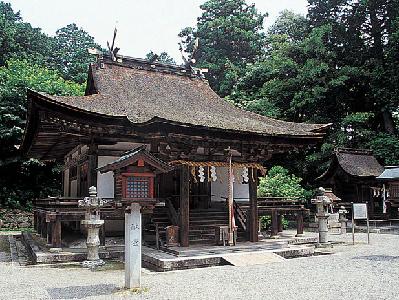|
Mikami Shrine enshrines Mt. Mikami or popularly called Omi-Fiji, a 432 m conical mountain in Shiga Prefecture, and Amenomikage no Kami, the guardian deity of old Omi province and the deity of blacksmith and blade smith.
The main hall constructed in the Kamakura period (1192-1333) is a very unique building in the style called Mikami-zukuri, in which the architectural styles for shrines, temples and residences are combined together. The Buddhism architectural style can be seen in its 3-bay structure, the Irimoya-zukuri roof, white walls and lattice windows. As one of the oldest shrine building in the Irimoya-zukuri style, it was designated as a National Treasure in 1952. The Haiden Hall (oratory), the main gate, the main hall of an attached shrine, Wakamiya Shrine, and the wooden Chinese dog are nationally designated as Important Cultural Properties.
Zuiki Festival is held at this shrine in the middle of October every year. The word “zuiki” means the stem of a taro potato. Every year five Mikoshi (portable shrine), which are made of zuiki and decorated with vegetables, persimmon leaves and chestnuts, are dedicated to the shrine to express gratitude for the year’s crop.
The main hall constructed in the Kamakura period (1192-1333) is a very unique building in the style called Mikami-zukuri, in which the architectural styles for shrines, temples and residences are combined together. The Buddhism architectural style can be seen in its 3-bay structure, the Irimoya-zukuri roof, white walls and lattice windows. As one of the oldest shrine building in the Irimoya-zukuri style, it was designated as a National Treasure in 1952. The Haiden Hall (oratory), the main gate, the main hall of an attached shrine, Wakamiya Shrine, and the wooden Chinese dog are nationally designated as Important Cultural Properties.
Zuiki Festival is held at this shrine in the middle of October every year. The word “zuiki” means the stem of a taro potato. Every year five Mikoshi (portable shrine), which are made of zuiki and decorated with vegetables, persimmon leaves and chestnuts, are dedicated to the shrine to express gratitude for the year’s crop.
| [+ADDRESS] | 
|


















